'The Ruhr certainly is getting the biggest bashing of its life': Rare handwritten letter by Dambusters hero Guy Gibson reveals his disbelief at how the Nazis were continuing to fight
-
•617 Squadron leader talks of England as optimistic and of Nazis struggling
-
•Thought to be Gibson's only letter ever sold as it goes up for auction
-
•Expected to fetch £3,000 at Bonhams in Knightsbridge on 12 November
By Mia De Graaf
PUBLISHED: 18:25, 14 October 2013 | UPDATED: 01:14, 15 October 2013
A rare handwritten letter from Dambusters hero Guy Gibson discussing the raid and the demise of the Nazi regime has been unveiled.
It was penned on 26 June 1943 - just five weeks after he led 617 Squadron's daring mission using the revolutionary bouncing bomb.
Thought to be his only letter ever sold, it is expected to fetch £3,000 at auction next month.
He was replying to fellow pilot Flight-Lieutenant Cecil 'Ginger' Parkins who had written to congratulate him on the raid and on his subsequent Victoria Cross.

Rare: National hero Guy Gibson was replying to fellow pilot Flight-Lieutenant Cecil 'Ginger' Parkins who had written to congratulate him on the raid and on his subsequent Victoria Cross
Gibson says: 'Life in England is much the same with everyone very optimistic. The Ruhr certainly is getting the biggest bashing of its life. How anyone can stick - I just don't know.'
One of the most celebrated figures of the Second World War, he masterminded Operation Chastise - the raid on the dams of the Ruhr valley on 16 and 17 May 1943 - which has achieved legendary status.
He was in command of 617 Squadron - 19 aircraft that set out to destroy the Mohne, the Eder and the Sorpe dams in the Ruhr Valley so as to damage a vital source of power to the key industrial heart of Germany.
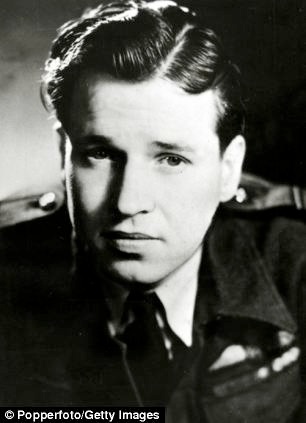
RAF ace: Guy Gibson was just 26 when he was killed in 1944 after his plane was downed by friendly fire
The first two were attacked and breached by mines dropped from specially modified Lancasters using bouncing bombs and the Sorpe was also damaged.
The daring night-time raid was hailed a success.
At the time Gibson wrote the letter he was still in command of the squadron which had been put together specifically to carry out the raids and was based at Cranfield in Bedfordshire.
Writing in the style of the day Gibson - who was killed a year later after his plane was downed by friendly fire in a night-time sortie over Germany - gossips about old times.
He said: 'I'm afraid Cranfield is not the same gay place it used to be. I must say G/c F.G. (Group Captain Fighter Group) was a wizard for parties. So old Pauline is out Eh? I hope someone married her!'
The letter starts rather affectionately 'My Dear Ginger' and goes on to say how nice it is to hear from him again.
Although close chums, at the end he signs it off very formally 'Guy P Gibson'.
Bonhams spokesman Andrew Currie said: 'Some of the language is quite old-fashioned and have a different context to today - when he talks about 'how anyone can stick' after the Dambusters raids means he doesn't know how the Germans can 'put up with' living there.
'One way of looking at it would be he could have had a little sympathy for those who were on the end of it.
'Cranfield not being as 'gay' as it once was means it was no longer as much fun - this was a common expression in those days.
'But we have no idea who Pauline was - she has been lost in the mists of time.'
Mr Currie said the letter - which is being sold anonymously by its owner - will be of interest to private collectors and institutions.
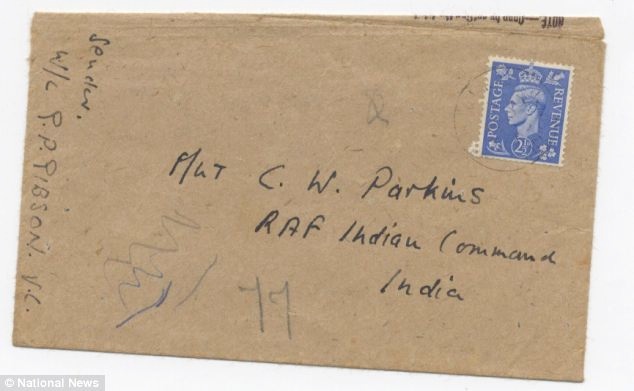
India: Gibson had been posted in India in 1943 during the war. The letter passes on tips to Ginger Parkins

Auction: It is expected to fetch £3,000 when it is sold at Bonham's in Knightsbridge on November 12
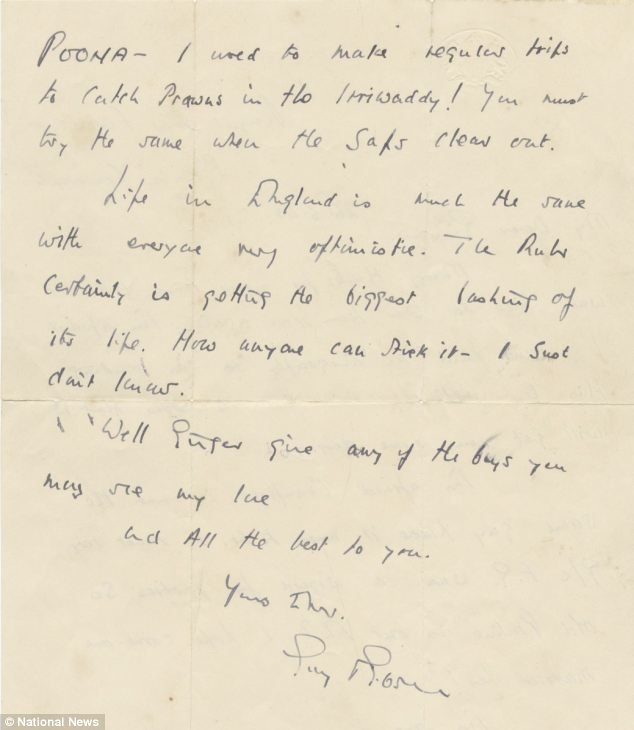
'Life in England is much the same with everyone very optimistic... Well give any of the boys you may see my love'
He said: 'Gibson died young and wrote very few letters during his short life as far as we know - ones that have survived are extremely rare.'
Gibson had spent his boyhood in India and passed on some tips.
He said: 'I'm sure you must love India! It's not a bad place - Now when I was in POONA - I used to make regular trips to catch Prawns in the Irriwaddy!(sic)'
Then referring to the Japanese invaders he said: 'You must try the same when the Japs clear out.'
The two-page letter is in good condition with only very light dust-staining and spotting.
Parkins met Gibson when they were both stationed at Cranfield in either 1941 or 1942.
He was posted to India in early 1943 and ended the war as Squadron leader at No 35 PTC RAF, Calcutta.
Gibson's Dambuster exploits were an important boost to national morale and he was considered too valuable to risk in further combat.
Having accompanied Churchill to Canada and subsequently served as a staff officer he eventually persuaded a reluctant 'Bomber' Harris to allow him to return to the air.
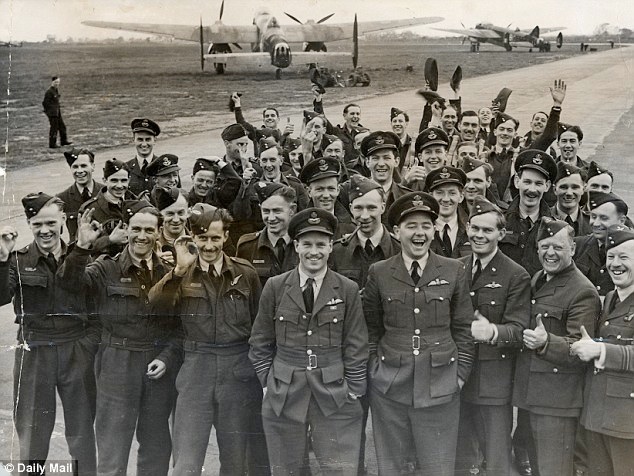
Heroes: RAF Bomber Command in the Second World War. Guy Gibson is seen (centre) with the air crews who took part in a raid on Cologne in 1942. Gibson won the Victoria Cross for his bravery in the Dambusters raid
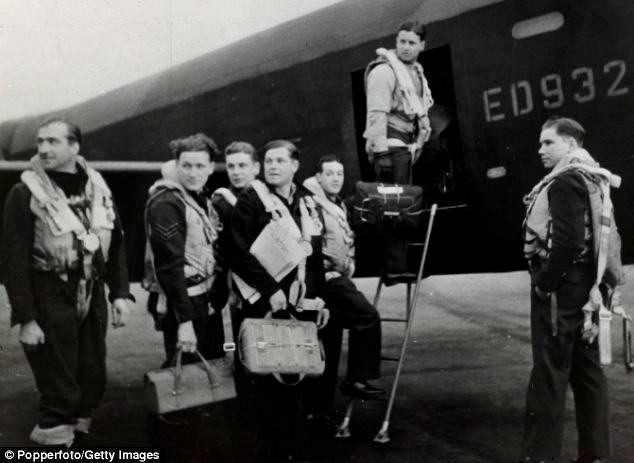
Gibson, 24, took control with no idea what was to come. Unusually, he was given authority to pick his own team
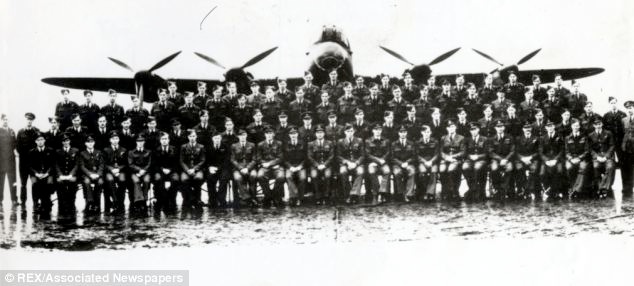
Squadron 617 'dambusters' Bomb Crew With One Of Their Lancasters. Gibson never led the team again
He was only 26 when he was shot down in September 1944 returning from his first mission after his return to active service.
Gibson died with navigator Jim Warwick when their twin-engined Mosquito was mistaken for an enemy plane.
His celebrated memoir, Enemy Coast Ahead, was posthumously published in 1946 and filmed as The Dam Busters in 1955.
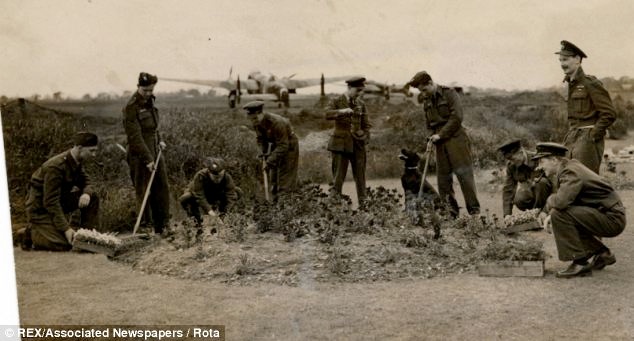
Guy Gibson Vc Dambusters hero with his devoted dog and fellow pilots tending their beloved garden
Mr Currie said: 'This is the only autograph letter by him of which we can find record that has appeared for sale.'
It's uncertain when he and Parkins first met but as the letter makes clear they overlapped at Cranfield where Gibson was stationed as Chief Flying Instructor between December 1941 and April 1942.
Mr Currie said: 'Family tradition holds he served as Gibson's best man in 1940 but neither we - nor they - have been able to verify this.
'He is however mentioned in Enemy Coast Ahead as having flown Gibson 'to the north of England' in March 1942.'
The letter will go on sale at Bonhams in Knightsbridge, London, on November 12.
DAMBUSTERS: THE NIGHT-TIME RAID THAT MADE GIBSON A NATIONAL HERO

National treasure: Guy Gibson V.C. (1918-1944), was commemorated with an English Heritage Blue Plaque on June 26 2006 at 32 Aberdeen Place, London, NW8
Gibson was the perfect choice to lead the 617 Squadron - colloquially dubbed 'the Dambusters'.
He had a flawless record, leadership skills and could fly the new Lancaster.
He took control of the mission with no idea what was to come.
Unusually, the 24-year-old was given the authority to pick his own team.
Gibson flew only the Dambusters raid with 617 Squadron despite them flying more precision bombing missions after.
The success of the Dambusters made Gibson the most highly decorated pilot in the RAF and gave him a place in history.
He was awarded the Victoria Cross - the highest and most prestigious award for gallantry in the face of the enemy that can be awarded to British and Commonwealth forces.
Usually, former commanders moved on to senior office-based roles to see out the rest of the war after a successful raid.
Army leaders and politicians encouraged him to do so - if he was captured or killed it would have seriously damaged British moral.
But Gibson insisted on operational duty.
He was initially posted at a Lincolnshire bomber base at East Kirkby on a strictly non-operational basis.
However, after persistent pestering from Gibson, they decided to let him lead a bomber squadron into Germany.
On September 19th 1944, Gibson led a huge force into Germany to attack railways and industrial targets at Monchengladbach and Rheydt.
Gibson did not return from the operation in his Mosquito.
Mystery and controversy have surrounded his crash ever since.
He orchestrated the attack and ordered the bombers home but was then never heard from again.
His Mosquito was seen plunging into the ground at Steenbergen in Holland. Part of his remains were later found.
Air Marshal Arthur Harris openly regretted his decision to let Gibson out into the field again.
Sir Barnes Wallis, who invented the bouncing bomb, described Gibson, saying: 'For some men of great courage and adventure, inactivity was a slow death. Would a man like Gibson ever have adjusted back to peacetime life?
'One can imagine it would have been a somewhat empty existence after all he had been through. Facing death had become his drug.
'He had seen countless friends and comrades perish in the great crusade.
'Perhaps something in him even welcomed the inevitability he had always felt that before the war ended he would join them in their Bomber Command Valhalla.
'He had pushed his luck beyond all limits and he knew it.
'But that was the kind of man he was… A man of great courage, inspiration and leadership. A man born for war…but born to fall in war.'